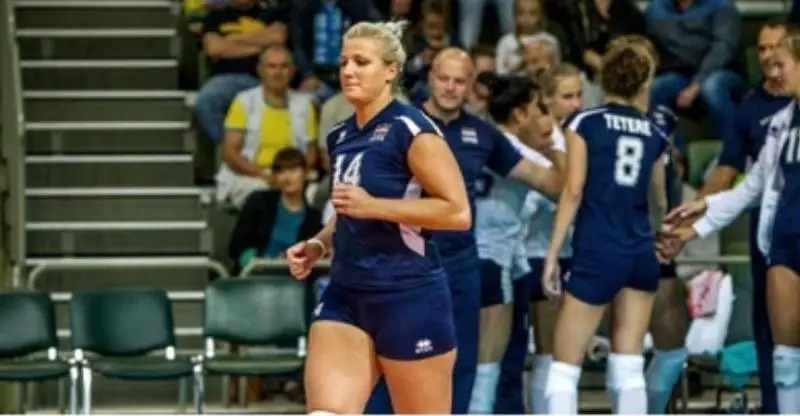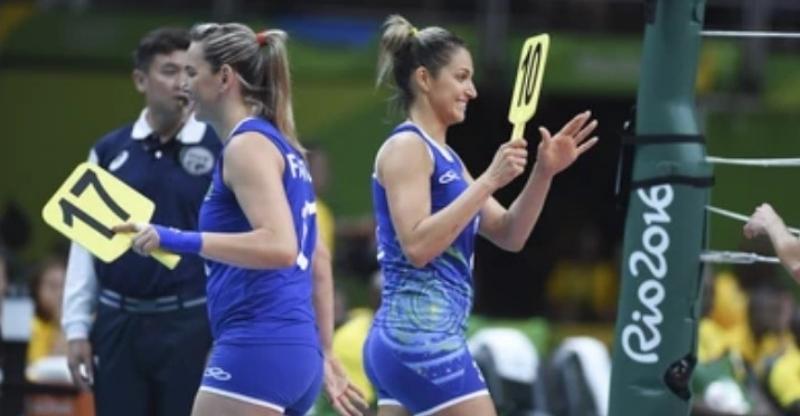Substitutions in volleyball are a great way to keep your players safe and change the flow of a match, but sometimes it can be hard to understand the rules behind it.
But first, what is a substitution? A substitution in volleyball is when one player enters the court as a replacement for another on their team. Each team may have a total of twelve substitutions per set – two for each position – which must be used by the same two players: the original and replacement. Moving the libero does not count towards this tally.
Not understanding how substitutions works can limit the effectiveness of your team by getting warnings from the ref, losing points from illegal substitutions, and potentially not being allowed to make any substitutions at all.
To prevent these things, I will cover everything you need to know for substitutions, including:
- FIVB vs USAV procedure for substitutions
- Libero replacement rules
- The 5 substitution strategies
What Is A Substitution In Volleyball?
In short, a substitution is a replacement, but let’s break it down further.
The FIVB rulebook (15.5.1) states:
“A substitution is the act by which a player, other than the Libero or his/her replacement player, after being recorded by the scorer, enters the game to occupy the position of another player, who must leave the court at that moment.”
A substitution retains the integrity of six players on court per team while allowing a change of personnel. This can be useful in many situations, especially to address injury or to replace a player with another whose skillset is more appropriate for the job.
A libero’s replacement on and off the court is technically not counted as a substitution, and we’ll explore this further down the article.
When Do Substitutions Happen In Volleyball?
A substitution can happen in volleyball at any time when the ball is not in play.
This includes between points, after timeouts, and even before a set begins. You cannot stop a point in the middle of play to make a substitution, and attempting to do so will result in a penalty for your team.
Substitutions happen primarily for three reasons: tactical, injury, or the referee’s discretion.
Tactical Reasons
For tactical purposes, substitution allows struggling players to swap out when in trouble, tired players to catch their breath, and for teams to play their best players at their strongest points.
There are many different theories and beliefs about how substitutions should best be used, but it’s fair to say that it changes for every team.
Injuries
Injury is a terrible occurrence in sport, but prevalent.
Special substitutions are allowed when serious injury occurs, as well as medical timeouts, but coaches will often try to switch their players out before this happens.
If you see your player limping, or playing unsafely, then it’s probably a good idea to use a substitute.
Referee’s Discretion
Last, substitutions can happen because of the referee’s discretion.
This covers mainly the rare instances of expulsion from the match, when the referee will kick a player out for dangerous play, rule breaking, or other misconduct.
In addition to other penalties the team suffers, they must also use a substitution to replace the player.
How Often Can You Make Substitutions In Volleyball?

Normally, each team has a total of twelve substitutions per set, with two for each position on court.
This means that each player can be replaced by another from the bench and replaced again with the original, but these players cannot substitute anyone else for the rest of the set (FIVB 15.6).
You can make substitutions as often as you like in volleyball, as long as it is between points of play. You can even make six substitutions at once, if every player entered the substitution zone at the same time. You are only limited by the total number of substitutions available.
Most coaches choose to hold their substitutions until absolutely necessary, since each player can essentially be switched once. Substitutions are a valuable resource that can change the pace of the game, and using them recklessly is often seen as a waste.
That said, if you’re the type who wants to change things up every point, go for it. After all, if you don’t spend your substitutions each set, you lose them!
Who Authorizes A Substitution In Volleyball?
The second referee always authorizes a substitution in volleyball; this is the referee standing by the scorer’s table (FIVB 15.10.3c).
If a second referee is not present for your match, the first referee will recognize the substitution and the scorer’s table will authorize it on the scoresheet.
Be sure to communicate with the reffing team on who is handling substitutions for peace of mind before the match begins.
FIVB Procedure For Substitutions In Volleyball
The substitution procedure in volleyball is very simple, and the FIVB rulebook (section 15.10) sets it out clearly:
- Substitutions must be carried out within the substitution zone. This is located between the center line (where the net is) and the ten foot line (“attacker’s line”), in front of the scorer’s table by the side of the court. Substituting from outside this line constitutes an illegal substitution.
- A substitution should only last the time needed for recording the substitution on the score sheet and allowing the players to switch. This starts at the moment any substitute player enters the substitution zone during a break in play, such as in between points or after a time out. If the player is not ready, the substitution is not granted and the team might be given a penalty.
- If the substitution is valid, the second referee authorizes it with hand motions and a whistle, allowing the two players to switch on and off the court. In FIVB, World, Official, and in some university matches, numbered paddles are used to streamline the substitution process and make it clear who is replacing who. In this instance, the substituting player holds the paddle number of the player they are replacing.
- If a team wants to make more than one substitution, all substitute players must be present at the same time for substitution.
These rules remain much the same for middle school, high school, and university play as well as professional levels, except in leagues that have agreed on exceptional rules.
The most common of these changes is seen at the middle school level, which often allows unlimited substitutions for inclusive play.
NCAA Substitution Rules in Volleyball (USAV Rules)
As far as substitutions go, USAV and FIVB are pretty much the same. The biggest difference is the reduction of substitutions:
USAV 15.1:
“Each team may request a total of two time outs and twelve substitutions per set.”
However…
“The number of substitutions may be reduced to six per set with one entry per player when necessitated by the competition format”
This might be for any number of reasons, depending on the format, but most usually found in tournament play. This ensures that rounds go faster and that smaller teams get to play on equal manpower footing as the larger competitors.
Aside from this substitution otherwise follows the same general guidelines as FIVB.
It’s worth noting that in the US, liberos can serve.
In this unique case, the libero does not need to exit the court and there does not need to be a completed rally between libero replacements as is usually required (as per USAV 19.3.2.1).
For coaches wishing to use this, simply rotate the affected non-libero players through the libero replacement zone and continue play as normal.
Beach Volleyball Substitution Rules
Beach volleyball is played in teams of two, without a bench, and as such there are no substitutions allowed (FIVB Beach 15.2).
In cases of injury, five minutes of medical timeout are allowed, and if the player cannot return to play, their team is declared incomplete and the match forfeit (as per FIVB Beach 17.1)
These rules may seem unfair, but beach prides itself on players’ self-reliance and tenacity, and having substitutions may detract from this mantra.
As beach volleyball is best of three sets and much shorter than indoor volleyball, the match will finish before players reach the level of fatigue for substitution.
Libero Replacement Rules
Under both USAV and FIVB rules (19.3), libero replacements are not counted as substitutions.
They are unlimited but must be completed between rallies, similar to substitutions.
The libero can then only be replaced by the original player or by a second libero, whose replacement functions that same as the first.
The libero replacement must take place in the libero replacement zone. This zone encompasses the entirety of the sideline from the ten foot line to the back baseline (or “endline”).
As a reminder, all normal substitutions must take place in front of the ten foot line, by the scorer’s table.
In short, the libero cannot be substituted for a player as normal, but can use their libero replacement in the back row whenever they wish.
What Is An Illegal Substitution In Volleyball?
Usually made by mistake, an illegal substitution happens when an invalid player is substituted in for a position.
This includes players that have been substituted for another position in that set already, started in a different position, are not on the team sheet, or are the libero. Switching in any player wearing an illegal number or uniform also counts as an illegal substitution.
Under FIVB rules, an illegal substitution results in the suspension of play, service given to the opponent, reversal of the substitution, and the points scored by the team at fault being canceled. This can be incredibly detrimental, since the opponents score remains the same!
An illegal substitution can also occur when players substitute outside of the substitution zone – such as attempting to substitute in front of their bench, behind the ten foot line, or from the baseline.
All substitutions must be made between the center line and ten foot line, in front of the scorer’s table, so that the referees can see clearly what is going on.
5 Substitution Strategies In Volleyball

1. Pinch Server
Serving is a difficult skill to master in volleyball, but when you do it can be a powerful tool. Pinch servers exist to substitute in during times of emergency and bail their teams out, showing how powerful a good substitution can be.
Strategically saving a substitution to switch in a powerful server for a weak one can give your team the edge, extending leads or shortening them, and even throw the opposing team into disarray.
This strategy is best used in tiebreaker sets or when sprinting for the finish, as you only get the one chance to pinch serve each set and once gone, is finished.
2. Defensive Specialist
Using a substitution to switch in a defensive specialist can also benefit a team which is struggling to pass difficult spikes or serves, and can be the perfect answer to a pinch server or power hitter.
While the defensive specialist can remain on court as a versatile role, some teams use it only as a substitute answer. This is most commonly used to break serving runs and answer a tough spiking line up, substituting back out once they reach the front row.
Having a defensive specialist on your bench is always a good idea, and something that should instill a sense of calm in the most chaotic points of matches, when you can substitute them in to take control.
3. Middle/Libero Server (USA)
While not technically a substitution, this strategy is extremely common where it is legal – in the USA – and solves every coach’s serving conundrum: how to make the middle’s serve stronger.
Unfortunately, middle blockers have a bit of a reputation in high school and university for being weak servers and even weaker passers. Having the libero take over this responsibility for them solves this, in theory.
Using the libero replacement rules, the serving middle blocker exits through the libero replacement zone, while the incoming middle blocker intended to play front court enters through it and takes their usual place.
The libero remains on court without exiting, serving from the baseline and (hopefully) performing better than the middle blocker.
Be aware, once the libero serves for a position on court, they can only serve for that position/player for the rest of the set, meaning that this strategy can only be used to cover for one player.
4. Second Setter
A rare substitution strategy is switching in a second setter for a player, usually the back court middle/libero player. This brings the total offensive capability of the team to its zenith: a 6-2 formation. This is called this due to having 6 hitters, 2 setters (the normal formation is a 5-1).
Having a second setter gives a team flexibility, opening the setters to hit and confusing the opposition. You can even substitute the second setter in for the primary one, giving them a chance to rest and clear their head.
This strategy is best used when running combo plays, especially when the team has two excellent setters with lots of game knowledge.
Use this substitution when you want to demonstrate your setters’ skills and outsmart the competition, but be careful of confusing your own team with what’s going on.
5. Power Hitter
Last but not least, we have the simple substitution strategy for when you need more firepower.
One of your hitters isn’t spiking hard enough, or scoring? Substitute one of your power hitters in to clean up the point.
Want an extra back court hitter? Substitute out your defensive specialist for a point or two.
Having a pocket power hitter to substitute gives you offensive power at a moment’s notice and allows you to play weaker members of the team with the knowledge that if you need to up your game, you can.
Rulebook Resources
- http://www.fivb.org/en/refereeing-rules/documents/fivb_volleyball_rules_2015-2016_en_v3_20150205.pdf
- https://indd.adobe.com/view/f27fc70f-e33f-4e78-b718-67b4ff2af0e0
- https://www.fivb.org/EN/Refereeing-Rules/Documents/FIVB-BeachVolleyball_Rules_2017-2020-EN-v05.pdf
Frequently Asked Questions
How Many Substitutions Are in Volleyball Per Set?
Each team is allowed a total of twelve substitutions in volleyball per set. Each position is allowed one substitution – being six total – and one to substitute the original player back, bringing the total to twelve. In some formats, such as unique tournaments, teams are given a maximum of six substitutions though.
What Is a Double Substitution in Volleyball?
A double substitution in volleyball is when two off-court players substitute for two on-court players at the same time. This is legal if both are in the substitution zone near the scoring table at the same time, and simultaneous substitutions can be up to six players at a time if all are present and ready to play.
What Is the Substitution Hand Signal in Volleyball?
The substitution hand signal in volleyball is a circular motion of forearms around each other, resulting in a “whisking motion”. This signal is only used by the second referee to signal a substitution is happening, but must be made by the coach when making an injury substitution also. Some players may make the motion when approaching the table, but this is not strictly necessary.
Will a Referee Blow One or Two Whistles for Volleyball Substitutions?
A referee will blow one whistle for volleyball substitutions. The referee will only whistle when the player is actually in the substitution zone though, and if the serving whistle goes before this happens you must wait until the next point to enter!
Other Rules In Volleyball
- Can The Libero Serve in Volleyball?
- How Long Is A Volleyball Game? (High School, College, Beach)
- When Does the Volleyball Season Start? (Broken Down By Level)
- What Does Sideout Mean in Volleyball? [Rally Scoring vs. Sideout]
- Can You Touch the Net in Volleyball? [Official Volleyball Net Touch Rules]
- Can the Ball Hit the Net on a Serve in Volleyball?
- Can You Reach Over the Net in Volleyball? (3 Illegal Plays & One That’s Okay)
- Can You Bring a Volleyball on an Airplane? (6 Things You Didn’t Know You Could Do With a Volleyball)
- Yellow Card in Volleyball? [6 Things You Didn’t Know About Volleyball Card Penalties]
- Volleyball Timeout Rules (And 4 Key Strategies Explained)
- Can You Use Your Head in Volleyball?
- Can the Libero Be Captain in Volleyball? [Plus 3 Useful Libero Rules To Know]
- In Volleyball, How is the Server Determined?
- Why Do Volleyball Teams And Benches Switch Sides?
- Can You Wear Volleyball Shoes Outside?
- Can You Kick the Ball in Volleyball? [The Real Reason Coaches Don’t Want You To Use Your Feet]
- Can You Block The Serve In Volleyball?
